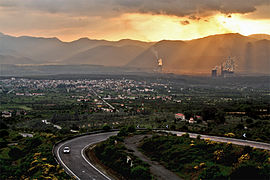|
Megalopolis, Greece
Megalopoli (Greek: Μεγαλόπολη) is a town in the southwestern part of the regional unit of Arcadia, southern Greece. It is located in the same site as ancient Megalopolis (Ancient Greek: Μεγαλόπολις, literally large/great city). When it was founded in 371 BCE, it was the first large urbanization in rustic Arcadia. Its theatre had a capacity of 20,000 visitors, making it one of the largest ancient Greek theatres.[2] Today Megalopoli has several schools, shops, churches, hotels and other services. The population of Megalopoli in 2021 was 5,344 residents.[1]    GeographyMegalopoli is situated in a wide valley, surrounded by mountains: the Taygetus to the south, the Mainalo to the north, the Tsemperou to the southeast and the Lykaion to the west. Its elevation is 430 m above sea level. The river Alfeios flows through this valley, coming from the east and flowing to the north, passing south and west of the town. Its tributary Elissonas passes north of the town. The large lignite deposits around Megalopoli are being exploited by open-pit mining. The Megalopoli Power Plant, 3 km northwest of the town centre, has produced electricity from this lignite since 1969. History Megalopolis is known for its ancient ruins situated northwest of the town centre, on both banks of the river Elisson. The ruins include an ancient theatre that used to hold up to 20,000 people and was 30 m (98 ft) tall. Other landmarks include the Thersileon with 67 pillars and a temple (11.5 m × 5 m or 38 ft × 16 ft).[citation needed] The area of Megalopolis features lignite deposits, which are prone to catching fire in summer and can smoulder and scorch the earth for weeks. In antiquity, it was often identified as the site of the mythical Gigantomachy where the Greek giants were defeated and killed in a decisive battle with the gods, possibly inspired by enormous bones dug up from around the area taken as giants' bones, as mentioned by Ancient Greek writers such as Pausanias. These have been conjectured in modern times to be those of Pleistocene fossil animals which are still often unearthed from the area today, such as those of the extinct straight-tusked elephant.[3] The city was founded through a synodical of twenty to forty neighbouring communities between 371 and 368 BC by the Arcadian League in an attempt to form a political counterweight to Sparta. Megalopolis was a member of the Arcadian League after its foundation until the dissolution of the federation in 362 BC. In 353 BC, when Thebes had her hands full with the so-called Sacred War, the Spartans made an attempt to reduce Megalopolis; but the Thebans sent assistance and the city was rescued.[4] In 331 BC, Megalopolis was invaded by the Spartans and there was a battle with the Macedonians that came to Megalopolis' help. In 317 BC at the start of the Second War of the Diadochi, Polyperchon, the new Regent of the Macedonian Empire, besieged Megalopolis which had sided with his enemy Cassander.[5] The siege failed.[5] In the 270s BC, Aristodemus the Good managed to take control over the city as a tyrant backed by Macedon. In 235 BC, the second tyrant of the city, Lydiades, gave up control over the polis and the city became a member of the Achaean League. In 222 BC, the Spartan king Cleomenes III burnt down the city, but it was rebuilt in the years after the destruction. As a member of the Achaean League, Megalopolis had a profound influence on the federal politics and it was the hometown of several notable Achaean figures such as Philopoemen, Lykortas and Polybius. Rome conquered Megalopolis during the Third Macedonian War in 146 BCE, as part of their conquest of Greece. The city remained populated under the Romans but by the 6th century it was almost completely abandoned. During the Byzantine era, and later also the Ottoman, the town on the same place was called Sináno (Σινάνο). It was renamed Megalopoli after the Greek War of Independence. Megalopoli retained a rural character until the early 1960s, when with the help of Megalopoli-born Prof. Leonidas Zervas (then Minister of Industry) the Greek Public Power Corporation started mining lignite in the Megalopoli Mine and the construction of the Megalopoli Power Plant followed soon.[6] The town was struck by the massive Arcadia earthquake of 5 April 1965, in which 17 inhabitants died and 80% of residences were demolished or rendered uninhabitable. MunicipalityThe municipality Megalopoli was formed at the 2011 local government reform by the merger of the following three former municipalities, that became municipal units:[7] The municipality has an area of 722.629 km2, the municipal unit 331.498 km2.[8] SubdivisionsThe municipal unit of Megalopoli is subdivided into the following communities (villages within the community in brackets):[7]
ProvinceThe province of Megalopoli (Greek: Επαρχία Μεγαλόπολης) was one of the provinces of the Messenia Prefecture. Its territory corresponded with that of the current municipality Megalopoli, except the municipal unit Gortyna.[9] It was abolished in 2006. Population
Notable people
See alsoReferences
External linksWikimedia Commons has media related to Municipality of Megalopoli.
|
||||||||||||||||||||||||||||||||||||||||||||||||||||||||||||||||||||||||||||||



